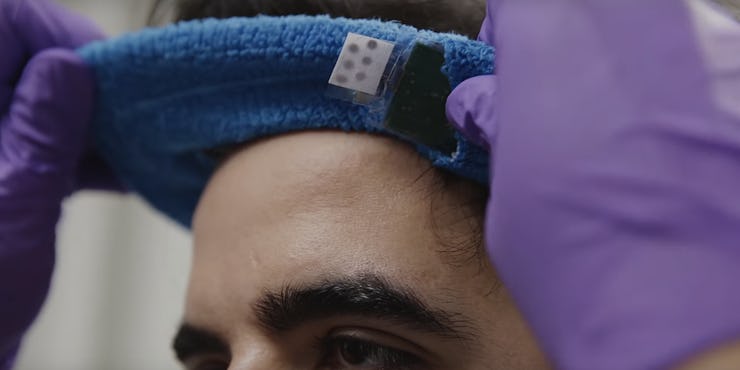This Sweat-Reading Headband Makes Other Smart Wearables Look Dumb
Unimpressed with basic biometric sensors, scientists develop a new device that tracks metabolites in sweat.

A new perspiration-reading headband from UC Berkeley that senses actual metabolites in your sweat has just set a new standard for what “smart” really means.
The sweatband uses a sensor — described in a study published today in Nature — that is the first to detect and analyze multiple chemicals in sweat in real time.
The rise of smart wearables has given us everything from pulse-tracking shirts to calorie-counting bras, but most products pack no more technological intelligence than a basic FitBit. Real talk: Smart clothing has been pretty dumb.
From your your sweatband to your phone.
Currently sensors are mostly limited to collecting data on movement and, in some slightly smarter cases, electrical activity in muscle. The biometric information they beam out to our smart phones, as a result, is pretty basic: Data on heart rate, breathing rate, steps, and calorie burn are all they can provide. For fitness buffs wanting to streamline their workouts, these biometrics will suffice. But Ali Javey, PhD, who led the study, isn’t just targeting health buffs — he’s set his sights on people needing medical attention.
Because sweat gives us a glimpse of what’s going on inside our bodies at the chemical level, Javey’s sensor could provide useful information to physicians wanting to monitor the health of their charges.
“Sweat provides us with a wealth of information about our body condition,” he said in an explanatory video. “It consists of a wide spectrum of different chemicals.”
Sorry, Richie Tenenbaum, your headband's as over as your tennis career.
His sensor measures chemicals including sodium and potassium, important electrolytes necessary for preventing dehydration. It also picks up on the metabolites lactate and glucose, which is produced by working muscle. Sweat glucose, eventually, might be used to monitor health in diabetics. As a bonus, it provides data on skin temperature (the glucose and lactate sensors are heat-sensitive and must constantly be calibrated).
The sensor effectively eliminates the need to take a patient’s blood sample, wait several hours for lab analysis, and then interpret the result, said George Brooks, PhD, a professor in UC Berkeley’s Integrative Biology lab, in the video. The resulting snapshot is instantaneous, a technology that has the potential to revolutionize medical practice, especially as the sensor is developed further to monitor a greater range of metabolites. How’s that for smart? (Just don’t throw it in the wash machine with the rest of your gym clothes.)